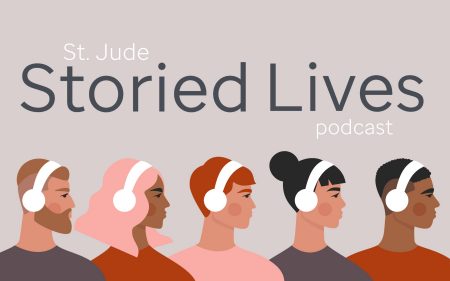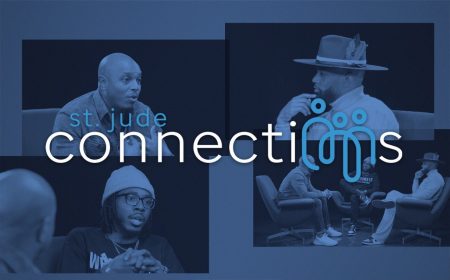
30-year partnership between St. Jude, a hospital and a foundation in El Salvador
A Salvadoran mother finds the answer to her son’s suffering and death from cancer.

April 19, 2023 • 5 min
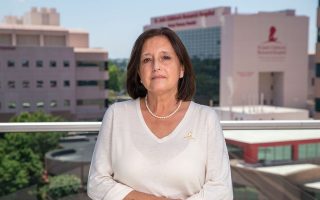
It was 1986, and doctors in Miami had already tried various treatments, but they could never diagnose the type of leukemia Ana Lina Peccorini’s son, Daniel, had. Ana Lina was told there was nothing else they could do, that she’d have to take her 2-year-old son home to die.
Then, St. Jude Children’s Research Hospital accepted him. Within two hours of the family’s arrival, Ana Lina said, doctors diagnosed Daniel with a rare cancer called acute megakaryocytic leukemia, a subtype of acute myeloid leukemia. Treatment gave Ana Lina three more months with her son.

Ana Lina Peccorini's son Daniel, who passed away on December 17, 1986
Daniel died Dec. 17, 1986.
“When my son died, I had the reassurance of feeling that we were giving him the best opportunity to live,” Ana Lina said. “As parents, we felt satisfied that we had reached the best place in the world, St. Jude. And that St. Jude had done the impossible to save him.”
After Daniel’s death, Ana Lina went back to her home country of El Salvador and grieved for five years.
“The first years were extremely difficult, mostly because the following year I gave birth to my third child, who also died as a newborn,” Ana Lina said. “And I think maybe that was my lowest point. But I had my eldest daughter … and I had to keep going. This was 1988. Then it took me two years to recover, but at the end of 1990 I felt the need to do something for children with cancer in El Salvador.”
That something was a foundation ― to help children with cancer in El Salvador at a time when nearly every child diagnosed in the country died. There were no pediatric oncologists, Ana Lina remembered, and the national pediatric hospital had no formal programs to treat kids with cancer. Most died without being treated at all. Ana Lina wanted Fundación Ayúdame a Vivir (Help Me Live Foundation) to change that.
“I had the blessing of giving my son the best opportunity in the world,” she said. “Even though he didn’t make it, it was a blessing for my family to take him to St. Jude, to the best place in the world. So, I needed to pay back that blessing.”
A bold ask that would change children’s lives forever
For two years, Ana Lina and a group of courageous women who shared the same vision worked passionately as a team to create an organization. She kept in touch with a St. Jude doctor, who offered support and advice on how to approach the right people at St. Jude.
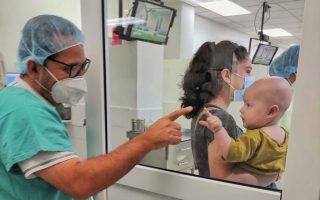
Dr. Roberto Vasquez of Centro Medico points to Johnny in his mother’s arms.
In 1993, she went back to the campus where the team tried so hard to save Daniel. But this time, she wanted St. Jude to help her help children in El Salvador. She remembers the interaction with one doctor in particular.
“I looked him in the eye and said to him, ‘I want to challenge you. I challenge you to go to El Salvador and see that it is worth helping.”
And he did.
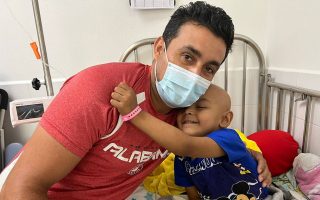
José with his dad at Centro Medico in El Salvador.
The country had just ended a 10-year civil war. A devastating earthquake had destroyed the pediatric hospital the same year Daniel died, but the German government had built a brand new one.
“When they arrived and saw that the infrastructure was adequate for the start of this program, they said, ‘Well, let's do it,’” she remembered.
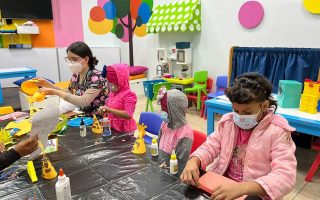
Centro Medico staff work with patients in El Salvador.
Ana Lina’s work spurred the partnership between St. Jude and Benjamin Bloom Hospital. This partnership led to the creation of the International Outreach Program at St. Jude, and to today’s Department of Global Pediatric Medicine and St. Jude Global.
The St. Jude Global Alliance brings together 232 hospitals and foundations in 69 countries that work together toward the same goal: to increase survival rates of children with cancer and other catastrophic diseases worldwide.
Despite advances, challenges remain
Roughly 93 percent of the patients Fundación Ayúdame a Vivir now serves are low-income and about 20 percent live in extreme poverty ― some in remote areas where there is little access to education and transportation is difficult. Many cannot read or write and can’t afford a bus ticket to the capital — if there’s a bus close enough to take. Some ride a horse or walk until they can reach a bus. One patient left with his family at 3 a.m., walked, rode two hours in a boat to reach the mainland then took four buses to reach the hospital, Ana Lina said. It would be easy for families to simply give up.
But the foundation wouldn’t abide that. They cover 100 percent of all Salvadoran children diagnosed with cancer who have reached out to the program. The organization not only provides medical treatment to patients, but also provides support in all areas that may be affected by a cancer diagnosis, turning into a comprehensive treatment by providing education, psychological support, social work, food and any additional needs they require at no cost to the patient and their families.
He never left
Today, Fundación Ayúdame a Vivir is the only non-profit organization that offers medical and supportive treatment for childhood cancer in El Salvador, at no cost to patients. The foundation covers children from birth to age 15 who are diagnosed.
Success has been monumental. Over the past 30 years, the overall pediatric cancer survival rate has gone from nearly nothing to 70 percent, Ana Lina said. And with some cancers, it’s as high as 90 percent. Now, less than 1 percent of children diagnosed with cancer in the country abandon treatment. And in 2008, the foundation built its own medical center.
“The dream we had 30 years ago was to give the same chance of life as a child in a developed country like the United States or Europe would have,” Ana Lina said. “And with great pride we can say that we have achieved it.”
Ana Lina’s greatest satisfaction, though, is that the foundation gives children the very best care and parents the comfort to know that when their children cannot be saved that everything possible was done for them, just as St. Jude did for her.
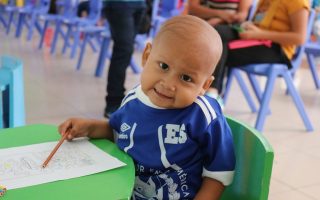
José Andres takes a break from coloring at Centro Medico.
“I feel that in every child we can save here at the foundation, that’s my answer for my son’s suffering and death,” Ana Lina said. “So really, it gives me a lot of peace to be able to understand why and for what he died.”
And yet, Ana Lina feels as if Daniel never left her.
Ana Lina’s other children talk of their brother as if they’ve always known him even though two were born after he died. One of her grandchildren carries Daniel’s name, and the family mentions him every day, and on every special occasion. Ana Lina still hangs his stocking at Christmastime.
“Now, even my grandchildren talk about their uncle, and they never met him,” she said. “And that’s the thing – he’s always there. He never went away.”
It is estimated that more than 400,000 children worldwide develop cancer every year, and nearly half of them are never diagnosed. In many low- and middle-income countries, 4 in 5 children won’t survive cancer, largely due to the lack of access to quality care. St. Jude Children’s Research Hospital believes children all over the world deserve the same chance at survival and is working with healthcare institutions and foundations across the globe to help make that dream a reality.
For more information about Fundación Ayúdame a Vivir visit https://ayudameavivir.org/



